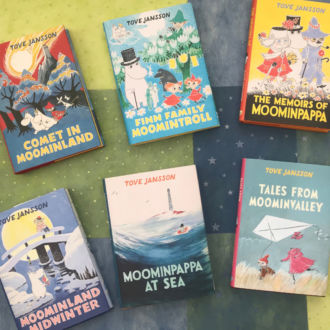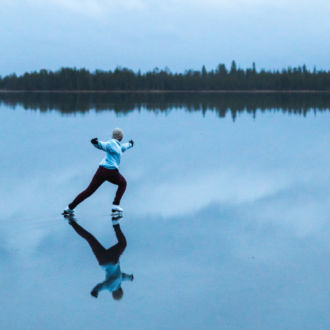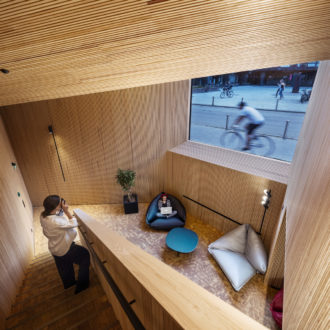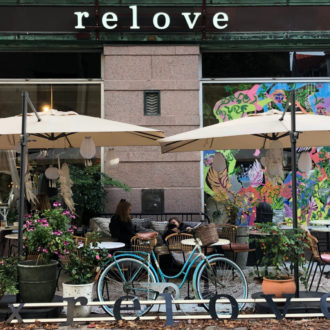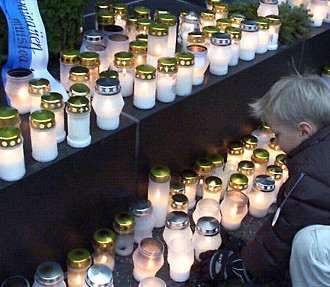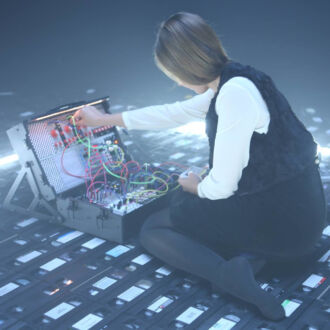A ryijy is a Finnish wall tapestry, traditionally made out of wool, sometimes also used as a blanket. Since the mid-20th century, the ryijy has seen a revival in art, fashion and interior design. It continues to grow in popularity amongst young artists.
Kunsthalle Helsinki’s exhibition Woven Beauty (until May 23, 2021) presents 130 magnificently designed Finnish ryijy artworks, the oldest made in 1707. If the exhibition is out of reach for reasons of geography or coronavirus-related restrictions, or if you’re reading this after the fact, our article and its photos can provide insight into an age-old Finnish art form that is constantly renewing itself.
History and modernity
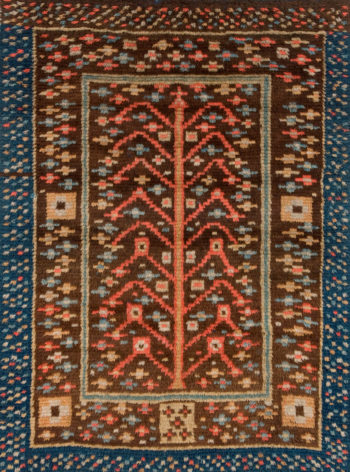
Ryijy with a single tree dates back to about 1800.Photo: Kunsthalle Helsinki
The Kunsthalle Helsinki selection draws on the collection of Tuomas Sopanen, who owns nearly 600 ryijy tapestries, making his the largest private ryijy collection in Finland. Sopanen and curators Juha-Heikki Tihinen and Eeva Holkeri combined their personal expertise to put together the exhibition, which showcases both historical and contemporary pieces, as well as a rich variety of techniques and materials.
Many of the works and designs are by prominent Finnish textile artists, including Uhra-Beata Simberg-Ehrström, Irma Kukkasjärvi and Armi Ratia. Ratia went on to found the internationally successful textile design company Marimekko. There’s even a ryijy by Akseli Gallen-Kallela, who is better known as one of Finland’s most famous painters.
With their faded colours and fabrics, some of the older ryijy works bring a sense of history to the exhibition. This is “part of their charm,” Tihinen says. Holkeri adds, “I am very fascinated and impressed by the technical virtuosity of older ryijys.”
Original art
This short guided tour of the Kunsthalle Helsinki exhibition provides a glimpse of many of the works on display.Video: Kunsthalle Helsinki
Although linked to Swedish rya and Norwegian rye techniques, ryijy holds a place in Finnish art and textile history. The first Finnish ryijy tapestries were used by Vikings in the ninth century. The thick wool coating provided warmth, and water did not damage it, making the ryijy an ideal boat cover. In the following centuries, the ryijy was used as a bed cover and even as a sleigh blanket. A bride or one of her relatives would often create a bridal ryijy to commemorate the wedding.
Since the 19th century, both artists and scientists have studied the origins of art and aesthetics by examining textiles and other alternative art forms, including ryijy. It occupies a significant place in Finnish art history, connected to international artistic currents as well as time-honoured traditions. In the post-war era, contemporary movements such as Finnish modernism and abstraction found their way into the ryijy world. During this period, ryijy tapestries also became widely regarded as an art object suitable for display in people’s homes.
Many pieces in the exhibition include symbols such as a rose, a tree of life or an hourglass. These symbols can reveal the origin of the ryijy as well as its intended purpose. For instance, the tree of life motif from central Finland includes branches and fruit, and was said to bring good luck to the family that received it as a gift.
Tihinen shares one of his preferred works from the collection, Simberg-Ehrström’s Oras (The New Crop, 1972). The piece features the artist’s own initials, indicating that it is a first edition. Simberg-Ehrström played with colour, creating the impression that the centre of the ryijy is lighting up. “This is one of the finest things which has been done” in ryijy art, says Tihinen. (Oras is also included in the video above.)
New directions

Jonna Karanka’s Every Season’s Ry or Ru (2016) incorporates feathers and beads, showing how modern-day artists are continuing to develop the ryijy medium.Photo: ThisisFINLAND
The exhibition also features modern, eye-catching, experimental pieces, including Jonna Karanka’s Every Season’s Ry or Ru and Tenka Issakainen’s Rosanvärinen ryijy (Ryijy the Colour of Rosa). Both Karanka and Issakainen are prominent contemporary ryijy artists. Their works may combine colourful fabrics with decorative objects including feathers, a bra strap, a toy guitar, beads, tinsel or flowers.
Many of the newer pieces can be considered part of a new wave of postmodern ryijy art. This budding genre is characterised by experimentation with form and materials, challenging the foundational concept of what a ryijy is. Nonetheless, contemporary artists continue to reflect upon the traditional elements of the art form. They “play with the tradition, and the limits of the ryijy tradition, in various ways,” says Tihinen.
The ryijy is finding its place in various cultural and artistic spaces. “It is interesting to see that craftsmanship and making crafts are valued,” says Holkeri. “Weaving ryijys can be seen as a counterweight to the fast pace of life.”
The traditions and art of Finnish ryijy will continue to inspire art enthusiasts and upcoming young artists. As I walked through the gallery, I heard one museumgoer say to another, while admiring the artworks, “Maybe you should dig out that ryijy you have at home.”
By Emma De Carvalho, April 2021
